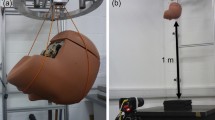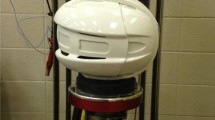Abstract
Low-energy impact testing of hockey shin guards was carried out using a drop test impact rig and a new physical setup protocol. Two brands of shin guards were impacted once (2.6 J, 3.3 J; without and with a sock), and impacted three times (3.3 J; with a sock). The peak force and impulse of a single impact increased with increasing impact energy (by approximately 30 and 7%, respectively) whilst repeated impacts increased the peak force and decreased the impulse (by approximately 70 and 3–9%, respectively, between one and three impact events). The presence of a sock attenuated impact force to a greater extent than the guards alone, at both impact energies. As a sock is usually worn over hockey shin guards, its presence contributes to enhanced protection to the lower limb.








Similar content being viewed by others
References
Parkkari J, Kujala UM, Kannus P (2001) Is it possible to prevent sports injuries? Review of controlled clinical trials and recommendations for future works. Sports Med 31(14):985–995
Schiff MA, Caine DJ, O’Halloran R (2010) Injury prevention in sports. Am J Lifestyle Med 4(1):42–64
Vriend I, Valkenberg H, Schoots W, Goudswaard GJ, Van der Meulen WJ, Backx FJG (2014) Shinguards effective in preventing lower leg injuries in football: population-based trend analyses over 25 years. J Sci Med Sport 18(5):518–522
Velani N, Wilson O, Halkon BJ, Harland AR (2012) Measuring the risk of sustaining injury in sport a novel approach to aid the re-design of personal protective equipment. Appl Ergon 43(5):883–890
Theilen T-M, Mueller-Eising W, Bettink PW, Rolle U (2016) Injury data of major international field hockey tournaments. Br Med J 50(11):657–660
Backx FJG, Erich WBM, Kemper ABA, Verbeek ALM (1989) Sports injuries in school-aged children: an epidemiologic study. Am J Sports Med 17(2):234–240
Murtaugh K (2001) Injury patterns among female field hockey players. Med Sci Sports Exerc 33(2):201–207
Podgórski T, Pawlak M (2011) A half century of scientific research in field hockey. Hum Mov 12(2):108–123
Murphy DF, Connolly DAJ, Beynnon BD (2003) Risk factors for lower extremity injury: a review of the literature. Br J Sports Med 37(1):13–29
Boden BP (1998) Leg injuries and shin guards. Clin Sports Med 17(4):769–777
Boden BP, Lohnes JH, Nunley JA, Garrett WE Jr (1999) Tibia and fibula fractures in soccer players. Knee Surg Sports Traumatol Arthrosc 7(4):262–266
Cattermole HR, Hardy JRW, Gregg PJ (1996) The footballer’s fracture. Br J Sports Med 30(2):171–175
Francisco AC, Nightingale RW, Guilak F, Glisson RR, Garrett WE (2000) Comparison of soccer shin guards in preventing tibia fracture. Am J Sports Med 28(2):227–233
Nyquist GW, Cheng R, El-Bohy AAR, King AI (1985) Tibia bending: strength and response. SAE Technical Paper 851728. The Society of Automotive Engineers, New York
Templeton PA, Farrar MJ, Williams HR, Bruguera J, Smith RM (2000) Complications of tibial shaft soccer fractures. Injury 31(6):415–419
Ankrah S, Mills NJ (2003) Performance of football shin guards for direct stud impacts. Sports Eng 6(4):207–219
Tatar Y, Ramazanoglu N, Camliguney AF, Saygi EK, Cotuk HB (2014) The effectiveness of shin guards used by football players. J Sports Sci Med 13(1):120–127
Ankrah S, Mills NJ (2004) Analysis of ankle protection in association football. Sports Eng 7(1):41–52
Naik NK, Shrirao P (2004) Composite structures under ballistic impact. Compos Struct 66(1):579–590
Karagiozova D, Shu DW, Xiang X (2016) On the energy absorption of tube reinforced foam materials under quasi-static and dynamic compression. Int J Mech Sci 105:102–116
Sevkat E, Liaw B, Delale F, Raju BB (2010) Effect of repeated impacts on the response of plain-woven hybrid composites. Compos B Eng 41(5):403–413
De Morais WA, Monteiro SN, d’Almeida JRM (2005) Evaluation of repeated low energy impact damage in carbon–epoxy composite materials. Compos Struct 67(3):307–315
Hrysomallis C (2009) Surrogate thigh model for assessing impact force attenuation of protective pads. J Sci Med Sport 12(1):35–41
Zahid B, Chen X (2013) Development of a helmet test rig for continuously textile reinforced riot helmets. Int J Text Sci 2(1):12–20
Zahid B, Chen X (2014) Impact performance of single-piece continuously textile reinforced riot helmet shells. J Compos Mater 48(6):761–766
Belingardi G, Cavatorta MP, Paolino DS (2008) Repeated impact response of hand lay-up and vacuum infusion thick glass reinforced laminates. Int J Impact Eng 35(7):609–619
Belingardi G, Cavatorta MP, Paolino DS (2009) On the rate of growth and extent of the steady damage accumulation phase in repeated impact tests. Compos Sci Technol 69(11):1693–1698
Dionne J-P, El Maach I, Shalabi A, Makris A (2003) A method for assessing the overall impact performance of riot helmets. J Appl Biomech 19(3):246–254
Stretch RA (2000) The impact absorption characteristics of cricket batting helmets. J Sports Sci 18(12):959–964
Gore SE, Laing RM, Wilson CA, Carr DJ, Niven BE (2006) Standardizing a pre-treatment cleaning procedure and effects of application on apparel fabrics. Text Res J 76(6):455–464
International Organization for Standardization (2012) ISO 6330: 2012 Textiles - Domestic washing and drying procedures for textile testing. Int Org Stand, Geneva
International Organization for Standardization (1996) ISO 5084: 1996 (E) Textiles - Determination of thickness of textiles and textile products. Int Org Stand, Geneva
European Committee for Standardization (1997) EN 12127: 1997 Textiles - Fabrics - Determination of mass per unit area using small samples. Eur Comm Stand, Brussels
British Standards Institution (1988) BS 5441: British standard methods of test for knitted fabrics. Section 2 part 8 determination of the number of visible wales and courses per centimetre. British Standards Institution, London
International Organization for Standardization (2005) ISO 139: Textiles—standard atmospheres for conditioning and testing. Int Org Stand, Geneva
Mitrevski T, Marshall IH, Thomson R (2006) The influence of impactor shape on the damage to composite laminates. Compos Struct 76(1):116–122
Mitrevski T, Marshall IH, Thomson R, Jones R, Whittingham B (2005) The effect of impactor shape on the impact response of composite laminates. Compos Struct 67(2):139–148
Rai R, Bhangu GS, Mohanty SK, Goel A (2002) Kinematic and temporal evaluation of swings, stick length and their interaction in field hockey. Med Sci Sports Exerc 34(5):1–18
Tobin L, Iremonger M (2006) Modern body armour and helmets: an introduction. Argos Press, Canberra
Thota N, Epaarachchi J, Lau KT (2015) Evaluation of the blunt thoracic trauma caused by solid sports ball impacts. J Biomech Sci Eng 10(2):14–00264
Addison BJ, Lieberman DE (2015) Tradeoffs between impact loading rate, vertical impulse and effective mass for walkers and heel strike runners wearing footwear of varying stiffness. J Biomech 48(7):1318–1324
Bertrand D, Bourrier F, Olmedo I, Brun M, Berger F, Limam A (2013) Experimental and numerical dynamic analysis of a live tree stem impacted by a Charpy pendulum. Int J Solids Struct 50(10):1689–1698
Pavier J, Langlet A, Eches N, Prat N, Bailly P, Jacquet J-F (2015) Experimental study of the coupling parameters influencing the terminal effects of thoracic blunt ballistic impacts. Forensic Sci Int 252:39–51
Flyger N, MacRae BA (2006) Impact rig user manual, 2nd edn. University of Otago, Dunedin, New Zealand, Clothing and Textile Sciences
SPSS Inc. (2013) SPSS version 22.0.0.0 for Windows. SPSS Inc, Chicago
Harris DA, Spears IR (2010) The effect of rugby shoulder padding on peak impact force attenuation. Br J Sports Med 44(3):200–203
Tyler DJ (2016) Impact protection for functional apparel. Paper presented at the The 90th Textile Institute World Conference: inseparable from the human environment, Poznan, Poland, 25-28 April 2016
Aslan Z, Karakuzu R, Okutan B (2003) The response of laminated composite plates under low-velocity impact loading. Compos Struct 59(1):119–127
Sankar BV (1992) Scaling of low-velocity impact for symmetric composite laminates. J Reinf Plast Compos 11(3):296–309
Verdejo R, Mills NJ (2004) Simulating the effects of long distance running on shoe midsole foam. Polym Test 23(5):567–574
Verdejo R, Mills NJ (2004) Heel-shoe interactions and the durability of EVA foam running-shoe midsoles. J Biomech 37(9):1379–1386
Gibson LJ, Ashby MF (1982) The mechanics of three-dimensional cellular materials. Proc R Soc Lond A: Math Phy Eng Sci 382(1782):43–59
Atas C, Icten BM, Küçük M (2013) Thickness effect on repeated impact response of woven fabric composite plates. Compos B Eng 49:80–85
David-West OS, Nash DH, Banks WM (2008) An experimental study of damage accumulation in balanced CFRP laminates due to repeated impact. Compos Struct 83(3):247–258
De Morais WA, Monteiro SN, d’Almeida JRM (2005) Effect of the laminate thickness on the composite strength to repeated low energy impacts. Compos Struct 70(2):223–228
Bir CA, Cassatta SJ, Janda DH (1995) An analysis and comparison of soccer shin guards. Clin J Sport Med 5(2):95–99
Feraboli P (2006) Some recommendations for characterization of composite panels by means of drop tower impact testing. J Aircraft 43(6):1710–1718
Author information
Authors and Affiliations
Corresponding author
Rights and permissions
About this article
Cite this article
Ruznan, W.S., Laing, R.M., Lowe, B.J. et al. Impact attenuation provided by shin guards for field hockey. Sports Eng 21, 161–175 (2018). https://doi.org/10.1007/s12283-017-0260-z
Published:
Issue Date:
DOI: https://doi.org/10.1007/s12283-017-0260-z




